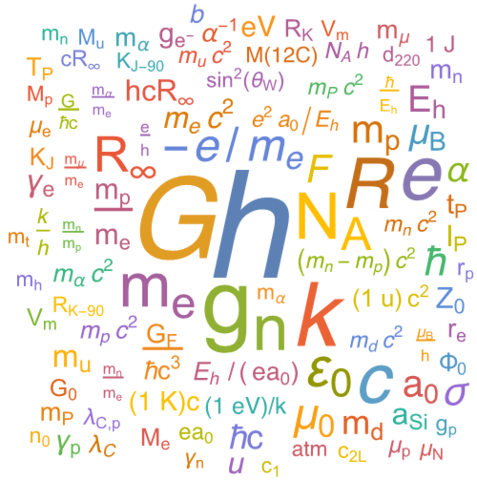
A word cloud representing usage of NIST's Fundamental Constants website between June 2018 and June 2019. The size of the symbol for a constant indicates how often its value is accessed. Usage data is from 200,000 unique page views..
K. Olsen/NIST
Four scientists from the National Institute of Standards and Technology (NIST) have reported the latest values for the fundamental constants of nature on June 30 in the journal Reviews of Modern Physics.
Maintaining and improving standards are important aspects of work performed at NIST. In collaboration with researchers around the world, NIST scientists regularly collate the world's most accurate values of the basic constants that appear in the laws of nature as currently understood. Examples are the masses of the electron, muon, and light nuclei as well as coupling constants such as the Newtonian constant of gravitation and the fine-structure constant. Equally important are physicochemical constants such as the Boltzmann constant.
The 2018 values of constants and conversion factors of physics and chemistry recommended by the Committee on Data of the International Science Council (CODATA) are the most recent available because CODATA updates the material every four years. The values are based on a least-squares adjustment that takes into account all relevant theoretical and experimental data available through 31 December 2018.
In the publication, major improvements as well as inconsistencies within the data are discussed. The former includes a decrease in the uncertainty of the fine-structure constant and nearly two orders of magnitude improvement in elementary particle masses due to the transition to the revised International System of Units (SI) with its exact value for the Planck constant. Further, because the elementary charge, Boltzmann constant, and Avogadro constant also have exact values in the revised SI, many other constants are either exact or have significantly reduced uncertainties. (Information about the revised SI can be found at BIPM or NIST's Metric Program.)
Inconsistencies within the data remain and will be cause for future deliberations. For Newton's gravitational constant the disagreement is among the sixteen experimental determinations performed over the past 40 years. The disagreement between measurements of the charge radius of the proton that has existed since 2010 is now partially resolved by improved measurements of hydrogen energy levels. The inconsistency for the magnetic moment of the muon, describing the way this elementary particle reacts to magnetic fields, is between an experimental and theoretical value. A 2021 measurement did not resolve this mismatch and might point to our inability to model quantum chromodynamics accurately.
The over 300 CODATA recommended values can also be found at physics.nist.gov/constants. This interactive website, operational since 1994, allows users to retrieve data on individual constants, groups of related constants, and correlations among constants. The word cloud on this page shows data on the frequency with which constants are requested by our users. The Newtonian constant of gravitation, G, and the Planck constant, h, are the most frequently requested constants and are arguably considered the most important. A bibliographic database of the relevant literature can also be accessed through the website.






